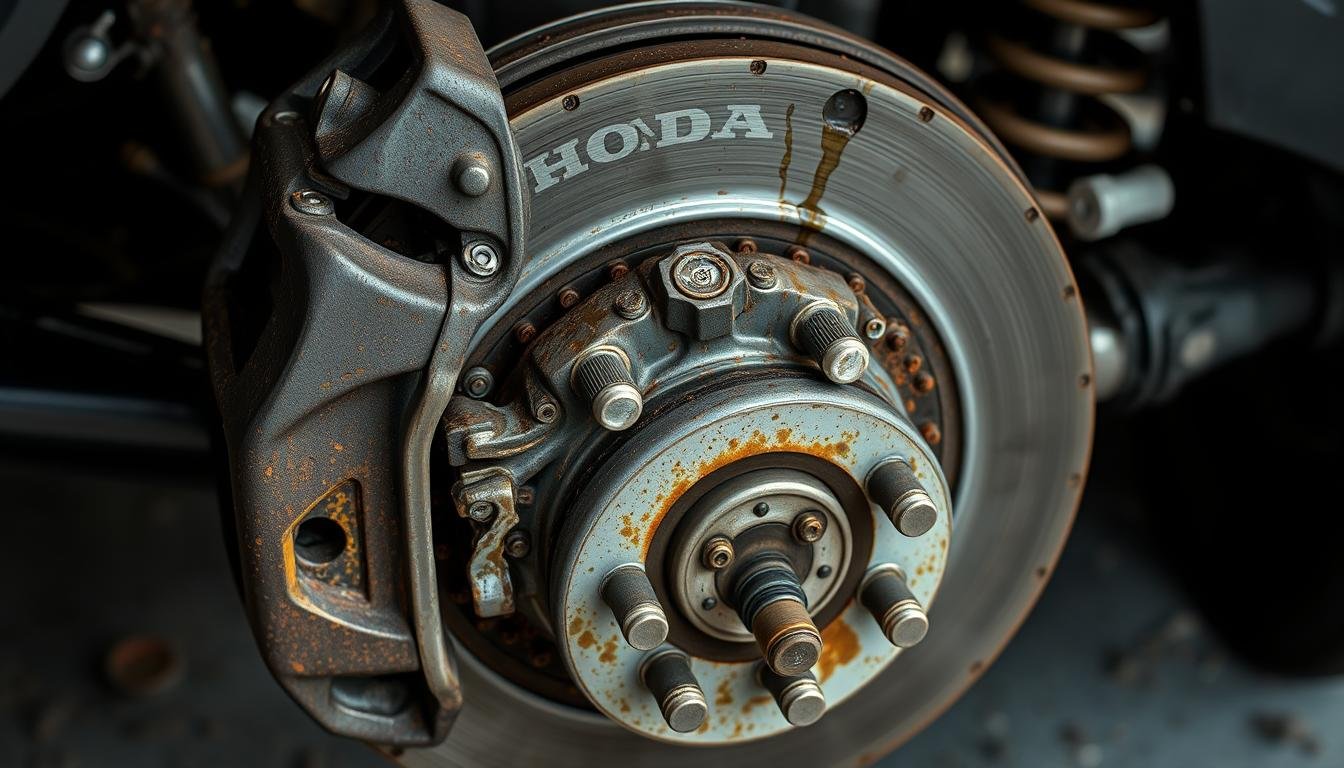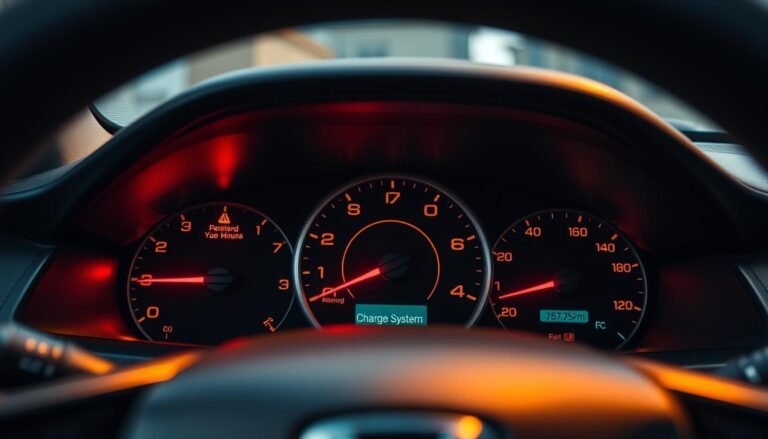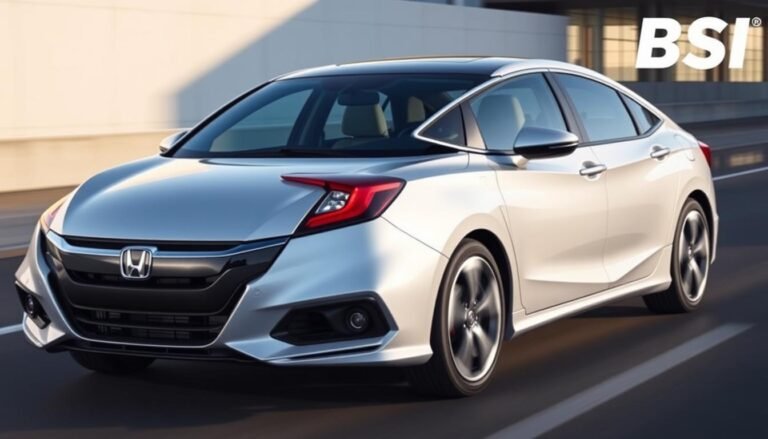Honda Brake System Problem: Essential 7 Causes & Fixes
Are you having trouble with your Honda’s brakes? Knowing what causes these problems and how to fix them is vital.
In this article, you’ll discover common issues with Honda brakes, signs to watch for, and how to solve them. We’re here to help you figure out what’s wrong with your brakes.
This guide covers major problems faced by Honda owners, from electrical issues to physical damage. You’ll get useful tips on fixing your brakes and stories from people who’ve done it.
Whether you choose to fix problems yourself or get professional help, understanding your brake system is key. Let’s explore the Honda brake system together and keep you safe on the road.
What is The Honda Brake System?
The Honda brake system is made of parts like brake pads, rotors, and calipers. These parts are crucial for safe and efficient stopping.
The system works using hydraulic pressure from the brake fluid. Problems with the system usually come from parts that are worn out or not working right.
It’s important to keep your Honda’s brakes in good shape to avoid trouble. Not taking care of low brake fluid levels can cause big issues.
Also, old brake pads won’t grip the rotors well, which can increase the chance of accidents. Knowing how these parts work together helps you spot problems early.
This means you can fix issues quickly. Regular maintenance not only makes your car safer but also helps your brake system last longer.
| Component | Function | Signs of Wear |
|---|---|---|
| Brake Pads | Provide friction to stop the vehicle | Grinding noise, reduced responsiveness |
| Rotors | Work with brake pads to create stopping power | Scoring, warping, vibrations while braking |
| Calipers | Engage the brake pads against the rotors | Leaking brake fluid, uneven wear on pads |
Common Honda Brake Problems
Knowing the common issues with your Honda’s brakes is key to staying safe on the road.
Spotting honda brake warning signs early lets you fix them before they get worse. This keeps your car running smoothly.
Identifying Brake Warning Signs
Honda brakes may show specific signs when there’s a problem. If the brake warning light turns on, you need to check it right away.
A mushy brake pedal might mean there’s air in the lines or you’re running low on brake fluid.
Grinding or squealing noises during braking are bad signs. They could mean your brake pads are worn out or your rotors are damaged.
Symptoms of A Failing Brake System
When your brakes are failing, you might notice several symptoms. It might get harder to stop your car. You may feel vibrations in the brake pedal when you use it.
And, a burning smell from your brakes is a red flag that needs quick checking. These issues are often due to worn-out brake pads, not enough brake fluid, or damaged rotors.
Fixing these honda brake problems quickly is crucial for safe driving.
Honda Brake System Problem: Causes & Fixes
Understanding the root causes of a Honda brake system problem is key. Two main issues often appear: electrical issues and physical damage.
Each issue can seriously affect your brake system’s performance, safety, and functionality. Let’s look into these problems to help you fix your Honda’s brake system.
Electrical Issues Impacting Brake Function
Electrical problems can make it hard for your Honda’s brakes to work right. Issues like faulty brake sensors or wiring problems can cause wrong alerts on your dashboard.
Sometimes, what seems like a brake problem is actually just a battery issue. Checking your electrical connections and sensors regularly helps in fixing these problems.
Physical Damage and Wear
Brake components like the brake pads can wear out, leading to brake failure. Even with good care, parts wear down over time. You might hear squealing or grinding noises, signaling it’s time for new parts. Keeping an eye on these components and replacing them when needed helps prevent bigger problems.
Troubleshooting Honda Brake System Issues
It’s crucial to troubleshoot your Honda’s brake system to keep it safe and running smoothly.
Start by giving the system a good look, checking if the brake fluid is low or if there are any leaks or damage.
If you find the fluid level is down, it’s time to search for leaks in the brake lines or parts. An OBD-II scanner is a great tool for diagnosing problems with your Honda’s brakes.
This device can reveal error codes. These codes can tell you exactly what’s wrong, helping you fix brake performance issues faster.

Step-by-Step Diagnostic Approach
Testing your brakes in various situations is key to understanding how well they’re working. Try stopping your car at different speeds to see what happens.
Be on the lookout for any odd noises or if the car doesn’t stop as expected. This hands-on testing is great for finding problems before making any repairs.
Also, pay close attention to how the brake pedal feels under your foot. If it feels too hard or too mushy, that could mean there’s a problem.
Checking Sensors and Electrical Connections
When fixing your Honda’s brake system, checking the sensors and electrical connections is super important.
Look at the brake pedal switch, the sensors for the anti-lock brakes (ABS), and the traction control. Make sure everything’s hooked up right and there’s no rust.
Fixing connections and changing out bad sensors can stop those scary warning lights about your brakes.
This careful checking will help you solve the most common brake problems fast and efficiently.
Common Honda Brake System Warning Signs
Being alert to honda brake warning signs is vital for your vehicle’s safety. Identifying these signs quickly can stop small issues from turning into big ones.
Knowing what dashboard lights mean and hearing odd noises helps a lot.
Dashboard Alerts and Their Meanings
Your Honda’s dashboard is a helpful tool for brake system health. It shows important alerts like the BRAKE SYSTEM warning and the ABS warning.
Each light signals different problems that need checking:
| Alert | Meaning |
|---|---|
| BRAKE SYSTEM | Possible problems with brake fluid, brake pads, or overall brake system failure. |
| ABS | Issues with the Anti-lock Brake System, affecting how well brakes work. |
Unusual Noises From The Brake System
Sounds like squealing or grinding are signs of common honda brake issues, often because of worn-out brake pads or parts not in line.
It’s very important to deal with these noises quickly. Ignoring them can cause more harm and expensive fixes.
Getting a mechanic’s help as soon as you hear odd sounds is key for keeping your car safe and running well.
Honda Brake Repair Tips
Keeping up with regular maintenance is key to making sure your Honda’s brakes work well for a long time.
By following good Honda brake repair tips, you can dodge big repair bills and boost your car’s performance.
Making a schedule for checks and changing the brake fluid is very important for the health of your brakes.
Maintenance Practices For Longevity
To make sure your brakes stay in top shape, follow these steps:
- Change the brake fluid every two years to stop moisture from building up.
- Look over the brake pads, rotors, and calipers for any wear or damage signs.
- Watch the brake pad thickness; swap them out if they get thinner than 1/8 inch.
- Check brake lines regularly for any leaks or cracks.
- Bleed the brake system to get rid of air bubbles in the fluid.
Doing these things can really help your braking system work better and last longer.
When To Seek Professional Help
Some brake repairs should not be done on your own. It’s important to know when to get help from a pro:
- If you hear grinding sounds or feel the brakes are mushy, see a technician.
- Go to a professional if brake system warning lights pop up on the dashboard.
- If checking or fixing brakes feels beyond your skill, better to rely on experts.
Pro technicians can spot problems you might miss yourself. Their knowledge in Honda brake maintenance can make your drive safer and head off future troubles.

Honda Brake System Maintenance
Keeping your Honda’s brakes in top shape is crucial for safety and performance. By doing regular checks, you can catch issues early.
This avoids expensive repairs and makes your drives smoother. Let’s talk about how to inspect your brakes and why changing brake fluid is essential.
Regular Inspection Techniques
Routine checks should include:
- Examining brake pads for thickness to ensure they are within the recommended limits.
- Checking brake rotors for signs of warping or wearing.
- Monitoring brake fluid levels and assessing its condition.
Having a detailed maintenance diary helps a lot. It lets you track all the work done and spot any repeating problems with your Honda’s brakes.
The Importance of Brake Fluid Replacement
Brake fluid can draw in moisture over time, hurting its performance. It’s key to change it regularly to keep your brakes working well.
If you skip this, the system’s parts might wear out faster. This could lead to bigger repair jobs later.
Honda Brake System Diagnostics
Mastering honda brake system diagnostics can really up your car care game. Tools like OBD-II scanners help check your brakes deeply.
They show error codes and point out parts that may need fixing. Learning to use these tools makes fixing problems easier.

Using Diagnostic Tools Effectively
Start by getting to know the common diagnostic tools. Here’s what you do:
- Connect the OBD-II scanner to your vehicle’s diagnostic port.
- Turn on the ignition to power the scanner.
- Select the option to read codes from the brake control module.
Knowing how these tools work helps you tackle brake issues better. Always check your car’s error codes to stay ahead of problems.
Reading Error Codes For Troubleshooting
When you get an error code, make sure you understand it right. Here is a simple way to deal with error codes:
- Compare the code against your owner’s manual.
- Look up the code online for more info.
- Know what the code means for your brakes.
This info is crucial for fixing your honda brake system right. Good diagnostics ensure your brakes are safe and last longer.
Fixing Honda Brake Problems at Home
Many Honda brake problems can be fixed at home. This saves you money and helps you learn.
Replacing brake pads, changing brake fluid, or fitting a new brake rotor are common tasks. Getting to know your way around a manual or guide is a good idea.
DIY Repairs For Common Issues
Fixing your car at home can be very satisfying. Some easy DIY repairs include:
- Brake Pad Replacement: Check for wear indicators and replace brake pads when necessary.
- Brake Fluid Flush: Old brake fluid can lead to reduced performance. Flushing the system will help maintain optimal braking efficiency.
- Rotor Swap: If the rotors are warped or excessively worn, replacing them can improve braking performance.
Tools You’ll Need For Brake Repairs
Make sure you have all the necessary tools before you start. You will need:
- Jack
- Jack stands
- Lug wrench
- Socket set
- Brake cleaner
- Torque wrench
Having the right tools makes fixing brake problems easier. These tips can help you deal with minor issues confidently. This will keep your car safe and performing well.
Expert Recommendations For Honda Brake Systems
Keeping your Honda brake system in top shape is essential. Experts highlight the importance of regular maintenance.
Many problems are due to not taking care of your brakes. Checking your brakes often and acting quickly if there’s an issue is crucial.
These steps help keep your car safe and running well. Tips for Honda brake repair can greatly improve your system’s condition.
Insights From Mechanics on Common Issues
Mechanics advise using OEM parts for the best fit and performance. Early detection of issues, like worn brake pads, is possible with regular checks.
Always pay attention to unusual sounds or behaviors. Maintaining a log of brake maintenance can pinpoint frequent issues. It also keeps track of the fixes made.
Learning Recalls and Warranty Options
Being aware of recalls for your Honda model is important. Recalls have solved many brake problems before, saving money on repairs. It’s also smart to know your warranty options well.
This knowledge helps when deciding on repair coverage. Knowing your warranty’s specifics is useful for when you need expert help.

Real-World Examples of Honda Brake System Problems
Exploring real-world examples of honda brake problems can help Honda owners understand what issues they might face.
The issues with the 2016 Honda Civic and the 2018 Honda Accord show important challenges. These examples stress the need to fix brake problems as soon as possible.
Case Study: 2016 Honda Civic Challenges
Many 2016 Honda Civic owners have reported issues with the electric parking brake. This problem usually happened after normal use.
Even after getting it fixed, the problem would often come back, suggesting deeper issues with the system.
This case shows why it’s critical to keep an eye on your car’s brake system, especially the electrical parts. They can cause big headaches and might need more than one repair.
Case Study: 2018 Honda Accord Battery and Brake Issues
The 2018 Honda Accord had unusual problems where brake warnings were actually due to a dead battery.
Drivers would see brake system warnings when the real issue was the battery. This highlights how complicated car diagnostics are today.
It shows that misreading these alerts can lead to unnecessary repairs. It’s important to understand the real problem to fix these common honda brake issues correctly.
Conclusion
Keeping your Honda’s brakes in good shape is key for staying safe on the road. It also helps your car perform its best.
By spotting common brake issues early, you can fix them before they get worse. Make sure to follow the honda brake repair advice we’ve talked about to take care of your brakes.
Doing regular check-ups, like looking at the brake fluid and parts, helps prevent brake problems. Knowing when it’s time to get expert help is also important.
This lets you handle any brake issues with confidence. With the correct knowledge and tools, you can solve brake problems easily.
This saves you time and money. More importantly, it makes your driving safer for you and others on the road.
FAQs
Q: What should I do if my Honda brake warning light is on?
A: If your Honda’s brake warning light comes on, first check the brake fluid. Look for leaks too. If the fluid is low or leaks are found, fix these problems right away. If everything looks OK, it’s wise to get a professional check.
Q: How can I tell if my Honda brake pads need replacement?
A: Squeaking or grinding noises when braking are key signs. Also, if braking feels less responsive or the pedal feels spongy, it’s time to check. Brake pads thinner than a quarter of an inch should be replaced.
Q: What causes a spongy brake pedal in my Honda?
A: A spongy brake pedal often means there’s air in the brake lines or the brake fluid is low. Check the brake fluid level first. Then, you may need to bleed the brakes to remove air.
Q: How often should I replace brake fluid in my Honda?
A: Brake fluid in your Honda should be changed every two years or as your service manual suggests. This prevents moisture build-up that can harm the brake system.
Q: What are common signs of a failing brake system?
A: Signs of brake system failure include stopping difficulties and vibrations when you brake. Unusual noises and a burning smell are also bad signs. If you notice these, get your brakes checked right away.
Q: Can I perform brake repairs on my Honda at home?
A: Yes, you can do some brake repairs at home, like changing brake pads or fluid. Make sure you have the right tools. And, follow reliable instructions for safety and success.
Q: When should I consult a professional for my Honda’s brake system issues?
A: If the problems continue after your own checks, or you can’t find the issue, see a certified Honda technician. They can offer a full diagnosis and repair.







